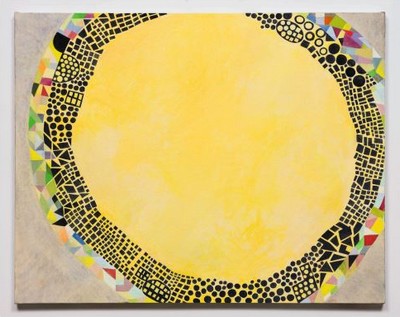Thomas Nozkowski: The Last Paintings
Pace Gallery, New York
September 10 – October 23, 2021
Untitled (9-69), 2019
Oil on linen on panel, 22" × 28" (55.9 cm × 71.1 cm)
© Estate of Thomas Nozkowski, courtesy Pace Gallery
Pace Gallery presents Thomas Nozkowski: The Last Paintings, an exhibition of the final paintings that Thomas Nozkowski completed before his passing in 2019. Marking the artist’s eighth show with the gallery since joining it in 2008, the exhibition features 15 works which Thomas Nozkowski rendered in oil on linen on panel between 2015 and 2019. Each painting showcases the enigmatic and uniquely variegated visual language for which Thomas Nozkowski was critically celebrated over his more than 40-year career. Seen together for the first time, they are also a culmination of the artist’s exploration of line, form, and color, and at the artist’s favored scale of 22 x 28 inches, the paintings invite close and sustained viewing. Richly hued and textured condensations that eschew any unifying style, they are deeply absorbing worlds unto themselves, and collectively celebrate the artist’s oeuvre.
On the occasion of the exhibition, Pace Publishing produces a catalogue celebrating the late artist. The publication features an essay by Marc Mayer alongside remembrances from members of Thomas Nozkowski’s artistic circle, including Peter Schjeldahl, Jennifer Gross, Karen Wilkin, Joseph Masheck, Catherine Murphy, Robert Storr, and Martin Puryear.
Over more than four decades, Thomas Nozkowski developed a singular approach to painting that rejected established aesthetic conventions. In the late 1970s, he abandoned the large-scale canvases popular amongst the Abstract Expressionists, with whom he studied at New York University and Cooper Union, in favor of small, 16 x 20 inch and later 22 x 28 inch canvas boards that were, in his words, “scaled for my friends’ apartments, that could hang in a three-room walkup tenement on 7th Street.” This modest size belied great ambition: each painting must work much harder in order to hold a viewer’s sustained attention. To that end, Thomas Nozkowski labored for hundreds of hours on each of his compositions, often scraping them down or rubbing them with a turpentine-soaked rag, so new images could float to their simultaneously dense and diaphanous surfaces. “If they get very dry,” he told one interviewer in 2015, “I’ll generally scrape them down and open them up again physically,” suggesting the surgical precision with which he reworked his paintings. Such effort is evidence of Thomas Nozkowski’s profound devotion to the painterly process, which he instilled in his students at Rutgers University, where he was a much-beloved professor in the Mason Gross School of the Arts.
In addition to his rejection of grand scale, he also refused the heroic individualism of his contemporaries, rarely hewing to a single style. Each of his paintings began with an image or images he observed from life—often on his daily walks near his home in New York’s Hudson Valley—and abstracted into forms that had never been seen before. Many of his works were inspired by images from art history, including Pisanello’s The Vision of St. Eustace (1438–42) and the Baths of Caracalla, though their references are never overt, leaving their meaning open to interpretation. As the critic John Yau observed, “By carefully loosening the conventions that undergird landscape painting, as well as using abstract shapes, Nozkowski arrives at a visual enigma that nevertheless feels rooted in nature and the everyday world.”
Using small brushes in order to force himself to slow down, Thomas Nozkowski found greater freedom in limitations. The Last Paintings showcase Thomas Nozkowki’s unparalleled range, with alternating registers of flatness and depth, biomorphism and rigid geometry, muted tones, and bright, vivid colors. His suppression of stylistic consistency was also refusal of the pressure for established artists to produce work characteristic of their personal brands, rather than pursuing new ideas wherever they might lead. Instead, Thomas Nozkowski was a lifelong learner as well as a teacher, always exploring his medium with patience and perspicacity. As he told the artist Garth Lewis in 2009, “a painter’s project, pursued diligently, will always start to inform itself. The work speaks back to you, takes positions, and presents ideas that point in new directions.” The Last Paintings are a distillation of that project, furthering Nozkowski’s radical aim to “free things from their history, from their strategies, from whatever constraints and imprisons painting.”
An online viewing room featuring a curated selection of archival works on paper by the artist runs concurrent to The Last Paintings on Pace’s website.
Jane Freilicher and Thomas Nozkowski: True Fictions, curated by Eric Brown, will open at The Milton Resnick and Pat Passlof Foundation on the Lower East Side in New York on November 5, 2021, and will remain on view through February 26, 2022.
THOMAS NOZKOWSKI (b. 1944, Teanek, New Jersey; d. 2019, Rhinebeck, New York) is recognized for his richly colored and intimately scaled abstract paintings and drawings that push the limits of visual language. An awareness of perception and the desire to explore the possibilities of seeing, is at once grounded in reality for the artist and released from specific legibility. His concurrent practices of painting and drawing reflect on specific places and experiences—from the deeply symbolic to the notational—translating sensations and memories into abstract compositions. Thomas Nozkowski began exhibiting in group shows in 1973 and made his solo debut in 1979. By 1982, the Museum of Modern Art, New York, had acquired a painting from an early one-person exhibition for their permanent collection. To date, Thomas Nozkowski’s paintings have been featured in more than 300 museum and gallery exhibitions worldwide, including over 80 solo shows.
PACE GALLERY
540 West 25th Street, New York, NY 10001

